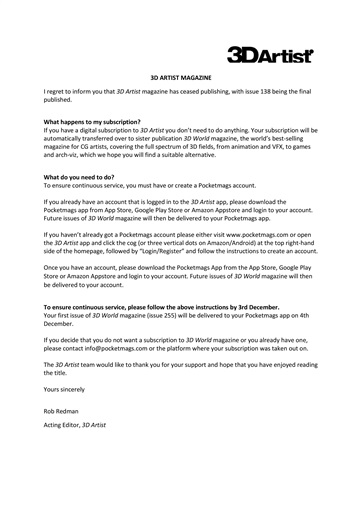

If you need a pyroclastic cloud with lots of nice sharp detail or the kind of incredible atmospheric effects you see in Alice in Wonderland – and you’re willing to put a day or two into those elements – it’s the right tool for that job. Splat is very fast, and when you need a wispy element, something that fills the screen in an atmospheric way, it’s the perfect solution because you can do an element in a few hours from beginning to end.īut we also have a package called Svea, which is our volume renderer. For example, we have two renderers we use for smoke. RB: It’s hard to figure out the right balance. The Splat renderer in action, on the 'spaghetti tornado' scene from 2009's Cloudy With a Chance of Meatballs.ģDW: Will CPU architectures continue to evolve fast enough to take the impetus off developing for the GPU?

And we’re getting render times of less than ten hours, sometimes less than six hours, per frame.

#3d world magazine issue 138 full
We’re doing things that would have been unthinkable a few years ago: scenes with full GI and millions of hairs, for example. RB: Any time you get an opportunity to do something – even something very complicated – many millions of times in a row, as long as it doesn’t require more onboard memory than you have on the GPU, that can be faster than on the CPU.īut it is amazing what CPUs are capable of today. RB: Given the complexity of the textures and the complexity of the geometry, the need for full GI, motion blur, hair, subsurface scattering – all the things we take for granted in a production-quality renderer – that doesn’t all fit today in the GPU, so it would have to be components.ģDW: So which components can be calculated efficiently on the GPU? So that could happen in future: that a component of the rendering could happen on the GPU, even for something like Arnold.ģDW: But only a component of the rendering, rather than the entire process? But the design goals of OSL include having a GPU backend, and if you were to browse on the discussion lists for OSL right now, you would see people working on GPU-accelerated renderers. The first target for that backend is the CPU, and that’s what we’re using now in production. RB: One of the goals behind the Open Shading Language is to make a clear area where we could customise the renderer for future computing platforms: a break between the language the engineers and artists are using and the actual execution backend. I believe that every show in the facility is now using it as its primary renderer.ģDW: So could Arnold, or components of Arnold, become GPU-based in future? It has been used on a lot of shows, but our primary renderer is Arnold.


 0 kommentar(er)
0 kommentar(er)
